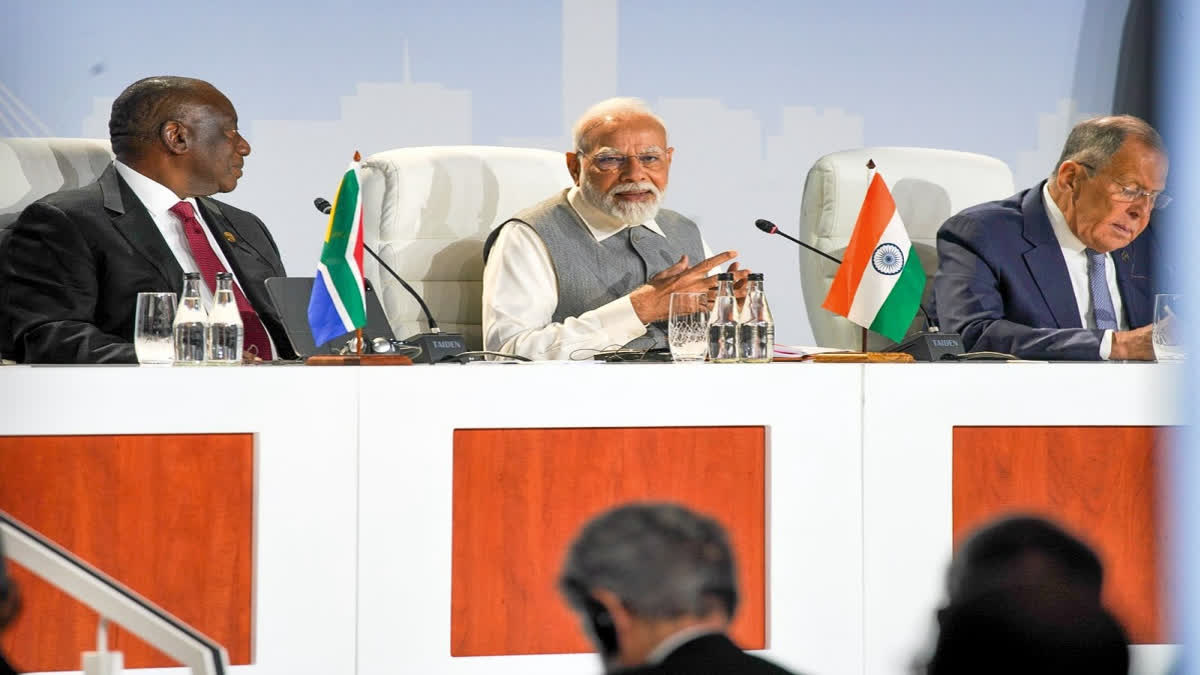New Delhi: With the Ministry of External Affairs announcing on Friday that Prime Minister Narendra Modi will be visiting Kazan in Russia next week to attend this year’s BRICS (Brazil, Russia, India, China, South Africa) Summit, the focus will again be on a new payment system under development for use among members of the bloc.
“The Summit, themed ‘Strengthening Multilateralism for Just Global Development and Security’, will provide an important platform for leaders to discuss key global issues," the Ministry stated while announcing PM Modi's visit for the Summit to be held on October 22-23. "The Summit will offer a valuable opportunity to assess the progress of initiatives launched by BRICS and to identify potential areas for future collaboration."
This will be first Summit to be held following the expansion of the bloc last year with the inclusion of Ethiopia, Egypt, Iran, and the United Arab Emirates (UAE) as new members. Though Saudi Arabia was also invited to join the bloc last year, it is yet to take a formal decision in this regard. An intergovernmental organisation that was originally formed to identify investment opportunities in member states, BRICS has evolved into a geopolitical bloc, with the governments meeting annually at formal summits and coordinating multilateral policies.
The BRICS members encompass about 30 percent of the world’s land surface and 45 percent of the global population. The bloc is considered the foremost geopolitical rival to the G7 bloc comprising the leading advanced economies, implementing competing initiatives such as the New Development Bank and the BRICS Contingent Reserve Arrangement.
With the inclusion of new members, this time there is likely to be a renewed focus on another initiative called BRICS Pay, a new payment system for cross-border transactions among the member states that has been in the works for some years now. In fact, as the host nation this year, Russia has called on the BRICS member states to create an alternative to the International Monetary Fund (IMF).
What does the BRICS Pay payment system entail?
BRICS Pay is a decentralised and independent payment messaging mechanism system under development by the BRICS member states. It is similar to Europe's SWIFT and India's Unified Payments Interface (UPI). The project is a joint venture between the BRICS member states to receive and make payments in their own local currencies.
The venture was launched in 2018 by the BRICS Business Council. The team that cooperatively runs BRICS Pay consists of financial, banking technology experts from the original founding nations of BRICS – Brazil, Russia, India and China - as well as South Africa. The purpose of BRICS Pay is to make international payments less costly and complicated, encouraging international cooperation between the growing crowd of BRICS members.
"The Bretton Woods-era global financial system is undergoing a significant transformation," the BRIC Pay website states. "We are witnessing rising global debt, increasing wealth inequality, and the fragmentation of trade and finance systems. Our goal is to ensure equal access to financial technologies and global wealth, providing everyone with the opportunity to reach their full potential. Today, we begin building a new, fair, and decentralised financial system for the future."
According to the website, to realise the BRICS Pay project, technological, financial, legal, and consulting firms are uniting to form the BRICS Pay Consortium, operating under the principles of a decentralised autonomous organisation (DAO).
"The Consortium adheres to the regulations of each country where its members operate," the website further states. "It is a network-based entity without a central headquarters. The Consortium’s membership is not publicly disclosed."
The BRICS Pay project aims to facilitate seamless transactions between member states and provide an alternative to existing global financial infrastructure dominated by Western systems like SWIFT. The key objective is to foster financial cooperation among the BRICS nations and reduce dependency on the US dollar in trade settlements, thus creating a multipolar financial world order.
Why was it deemed necessary to develop the BRIC Pay payment system?
BRICS Pay emerged from the growing need among BRICS nations to establish a payments system that is independent of the Western-led financial frameworks. This initiative comes amid geopolitical tensions and economic sanctions on countries like Russia. For BRICS countries, having an independent payment system enhances their financial sovereignty and enables smoother trade relations.
Countries like Russia have faced increasing sanctions, particularly after its conflict with Ukraine. These sanctions often limit access to international payment systems like SWIFT. This apart, BRICS nations wish to settle trade transactions in their national currencies rather than the US dollar, aiming for economic independence. Also, the global economy is increasingly moving toward digitalisation, making it imperative to develop new systems that support cross-border digital payments in a fast, secure, and transparent manner.
What are the important features of BRICS Pay?
BRICS Pay is being designed as a mobile payment system that integrates existing domestic payment platforms from each member country. This would allow users to transact with one another across borders using their local currencies, creating an interconnected payment ecosystem. The system will likely leverage blockchain or other advanced technologies to ensure transparency, security, and efficiency.
BRICS Pay is designed to handle multiple currencies, including the Russian rouble, the Chinese yuan, the Indian rupee, the Brazilian real, and the South African rand. It allows users to convert between these currencies seamlessly, making cross-border payments easier.
Russia has been especially proactive in advocating for an independent payment network due to its exclusion from SWIFT. Its Mir payment system, launched after the 2014 Crimea annexation sanctions, is likely to play a central role in BRICS Pay.
India has a well-developed domestic digital payment system through UPI, which has revolutionised payments within the country and is being gradually expanded for international use. China is already a major player in the digital payments landscape through UnionPay and WeChat Pay and has been exploring the Digital Yuan (e-CNY). Brazil and South Africa also have robust payment systems but have been slower to adopt cross-border solutions, making BRICS Pay an important catalyst for them.
To sum it up, the architecture of BRICS Pay envisions a more centralised structure within individual countries while maintaining a decentralised approach on an international scale.
"High-speed deployment, scalability, decentralisation, and interoperability are achieved through the creation of distributed networks for transmitting both payment information and liquidity," the BRICS Pay website states.



